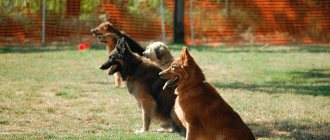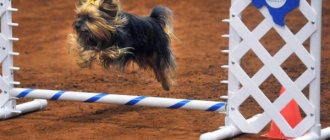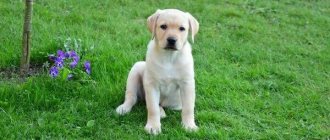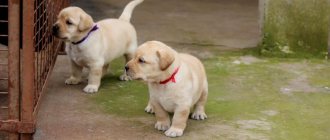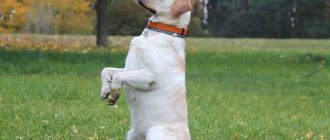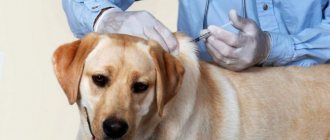The Labrador is a companion dog that needs love, attention, and proper training. The pet must learn basic commands; without this, life with an active, strong and sociable dog can be difficult. Specialists from the nursery can train the animal, but the owner himself can train a Labrador. The reward for your efforts will be a perfectly behaved dog, causing respectful surprise to those around you.
Labrador training: general course at home
Labrador training: why is it needed?
A charming Labrador puppy evokes a whole storm of emotions: tenderness, admiration, a desire to pamper and please the baby. However, from the very first days, the pet must be taught discipline, persistently explaining to it the rules of dog etiquette. Without them, an adult dog becomes poorly controlled and it will be difficult to communicate with it.
The main advantages of self-training:
- Convenience for the owner and his family. A well-mannered animal can safely walk without a leash, without running away or pestering passers-by. The pet does not spoil furniture and household items, does not litter, and calmly endures unpleasant procedures such as trimming nails or cleaning ears.
- Pet safety. After a training course, the dog will not break off the leash and will not get hit by a car. A Labrador that is trained not to take food from the ground or from a stranger's hand does not run the risk of being poisoned.
- Proper training brings out the dog's best character traits and mitigates some of its shortcomings.
- Professional training courses are expensive. Self-training will save money, and it is much more pleasant for the pet to work not with an instructor, but with the owner.
Labrador puppy
When drawing up a training course, you need to take into account the Labrador’s character traits. These dogs are different:
- liveliness and sociability;
- increased activity;
- playfulness;
- love for long walks;
- good nature;
- lack of aggression;
- high intelligence and memory;
- receptivity;
- good learning ability.
This breed was bred as a hunting breed, but over time it became clear that the Labrador's real purpose was as a companion. A dog can be trained so that it will become a good “nanny” for a child, and any family member can walk with the pet - from a baby to an old man or a person with disabilities. It is worth considering that a dog will not make an evil guard. He can become an observer and watchman, but he is not suitable for aggressive defenders. You should not raise a yard dog from a gentle, intelligent dog by limiting the animal’s mental abilities. But the Labrador will become a good companion, quickly learning to fetch things, accompany the owner, and guard purchases. If desired, your pet can be taught simple circus tricks; Labradors quickly remember them and willingly perform them to please their beloved owner.
The Labrador's real purpose is to be a companion.
You need to start learning with basic commands, gradually complicating and expanding the program. There is no point in relying on natural intelligence and not training your dog at all. A large, stupid dog can cause a lot of problems for itself and those around it; often such dogs become victims of tragic accidents.
Training refers to forcing a dog to perform certain actions in return for a treat or reward. When training, the natural qualities of Labradors are taken into account. Representatives of this breed are very easy to train, and you can start training at any age.
An ill-mannered dog can cause a lot of problems for himself and others.
How to stop a dog from chewing things in the absence of the owner?
You can cope with this problem with the help of special toys filled with food or seeds with flavoring. Buy such a product and give it to your dog, then leave it alone for 10 minutes. Gradually increase this interval to half an hour.
Keep an eye on the animal without being noticed. If he starts chewing on various things instead of toys again, punish him. If the dog only bites his bone, give him a reward.
General rules of training
Training must be consistent. It is advisable to conduct training at the same time, and both the owner and the pet should be calm and ready to work together. If the owner is irritated or in a hurry, it is better to postpone the classes, they will not bring any benefit. Advice from professional dog handlers will help you achieve success:
- Commands are given clearly, in a loud but calm voice. During the first training, it is important to wait for the dog to concentrate and pay attention to the owner.
- A command is valid if the action was completed within a few seconds. This will help link the order, execution and reward, reinforcing the correct response.
- You cannot give mutually exclusive or complementary commands. Having said “Aport!”, do not rush to shout “Sit!” or “Come to me!” — the pet will be confused and will not be able to respond correctly to the order.
- If your dog behaves incorrectly, you need to correct its behavior immediately. For example, when executing the command “Near!” The dog should not rush forward, pulling on the leash, lag behind or suddenly sit down. If the dog is stubborn, you need to put him on a short leash or hold him by the collar.
Puppy training must be consistent
All family members should participate in the training. They also communicate with the dog; it is important that everyone knows the principles of training and learned commands. General training is beneficial for the pet - he will understand that he must obey not only the owner, but also all members of the household.
Raising a puppy: where to start?
The first thing a puppy learns is socialization. Focusing on the mother, he gets used to the person and tunes in to communicate with him. Commands are involuntarily stored in the subconscious, even if the puppy does not understand their meaning. A young Labrador gets used to relieving himself in a certain place, knows where the bowls of food and water are, and where the place to sleep is. The better the puppy's mother is raised, the more skills the baby will gain.
A purebred Labrador moves to a new home at the age of 3 months. By this age, the puppy receives its first vaccinations and begins to go outside. Three months of age is the time when a dog’s character begins to form.
The basic principles when training a puppy are gentleness, consistency, perseverance.
At the beginning of training, the dog must firmly remember its own name. For a Labrador, it is better to choose a sonorous, not too long nickname that does not coincide with the names of family members and other pets. You should not overuse affectionate nicknames - this will lengthen the memorization process. Ideally, the puppy should run up at the first call, first for a treat, and then simply for the owner’s approval.
Important! You should not expect that the puppy will learn the necessary course in a couple of weeks. If you start training on time, it can take up to 6 months to master the main program. It all depends on the individual characteristics of the pet and the abilities of the trainer.
The basic principles when training a puppy are gentleness, consistency, and perseverance. You can’t forget about studying for a week and then quickly try to catch up. You need to train your pet while in a calm mood. It is important not to rush, not to shout, not to confuse commands. The puppy must clearly understand what the owner wants. You should not change the words, saying instead of “Come to me!” “Come here” or “Let’s go for a walk!” This will disorient an inexperienced dog and it will not be able to learn commands.
Give me your paw!
Table. Starting to learn skills and commands as a Labrador puppy
| Skill | Team | Degree of difficulty | When to teach? |
| Perform natural necessities on the street | "Walk!" | Simple | After the main course of vaccinations (from 2 to 3 months) |
| Do not perform actions that the owner does not like | "Ugh!" | Complex | From 3 months |
| Approach the owner | "To me!" | Average | From the first days of arrival in the house |
| Unquestioningly go to the designated place (bed, bedding) | "Place!" | Average | From the first days of arrival in the house |
| Sit down | "Sit!" | Average | From 4 months |
| Lie down | "Lie!" | Average | From 4 months |
| Follow next to the owner on the left side | "Near!" | Complex | From 4 months |
| Bring the required item | “Aport!” | Simple | From 3 months |
| One time bark | "Voice!" | Simple | From 4 months |
| Sit down and offer your right paw | “Give me your paw!” | Average | From 6 months |
The first training time does not exceed 10-15 minutes. The puppy is still too small, he gets tired quickly, and his attention wanders. It is best to train your pet 2-3 hours after eating, when he is quite alert and in the mood to communicate. It is important to ensure that your pet does not overeat, otherwise he will become lethargic and drowsy. After training, you can play with the puppy or let him run around in a fenced area.
Accustoming to a nickname
You may remember the movie Beethoven, in which a St. Bernard puppy chooses his own name. There is nothing impossible about this: animals are smart and quickly isolate from the flow of speech the word with which they are most often addressed. Therefore, in order for your puppy to quickly learn his name, it is important to call him as many times a day as possible, repeating the name.
This can be done as follows:
- call them to eat by name - Labrador babies should eat at least five to six times a day;
- calling by name during games;
- call by name, or repeat the nickname if the puppy is already running towards you;
- repeat the name while stroking the baby. Then he will associate the nickname with something pleasant.
Thanks to the intelligence inherent in all Labradors, your puppy will remember his name within a few days, and then begin to respond to it.
Training an adult Labrador
Often, training begins not from a young age, but after the dog is one year old. Don't get upset and think that everything is lost. Intelligent, receptive and eager to please its owner, a companion dog is quite capable of getting a crash course at any age.
Labrador can take a crash course at any age
If training was started in a timely manner and the puppy has correctly learned the basic commands, you can move on to a more complex program. For example, when following the order “Place!”, the Labrador must not just go to his bed, but sit where the owner indicates. After the command “Near!” The dog should follow the owner's left leg so that its head is near the hip. When the owner stops, the pet immediately sits down; after resuming movement, it gets up and continues to walk nearby. When executing the command “Come to me!” the dog must approach the owner and sit near his left leg.
In complex training, a command is counted only if the pet completes it cleanly, quickly and completely. In this case, he receives a treat and praise. The training time increases to 40-60 minutes. It is most convenient to train a dog in a special area or vacant lot, where it can be safely let off the leash.
Often, training begins after the dog is one year old.
Labradors are usually quite smart and try their best to please their owner. But sometimes you come across pets that are too cheerful and difficult to control, and a strict collar is used to train them. It can be used occasionally, preferably under the supervision of an experienced instructor. This type of training should not be used on dogs under 10 months of age. With a strict collar they practice the command “Fu!”, while learning the orders “Place!” or “Nearby!” it is not used.
Curiosities are inappropriate
The commands “Crawl”, “Barrier”, “Show your teeth” and many others can be useful for a Labrador. The puppy acquires preliminary skills in fetching objects at a young age, when he plays ball with his owner or runs after an abandoned stick. These fun activities will help develop your pet's desire to search, grab with his teeth and bring things to his owner. After all, for every such action he receives his favorite treat.
If you want to control your dog using gestures, then it is not that difficult. During the general training course, you need to show a certain gesture along with a voice command. The dog will simultaneously remember both sounds and movements. Just like voice commands, gestures must be demonstrated clearly and always in the same way. Otherwise, even a funny situation may arise. Without really understanding what exactly the owner was showing, but wanting to please him, the Labrador will begin to follow all the commands that he knows in a row.
The gesture of waving at an animal can cause great harm. It’s better to never do this at all if you don’t want your pet to become timid and shy away from every wave of your hand.
Etiquette rules: what should a Labrador do?
A puppy who regularly goes outside must learn the commands “Come to me!” and “Ugh!” If he does not perform them clearly, the dog cannot be let off the leash. She will be able to walk freely only in a safe, protected area.
It is very important to accustom your young Labrador to a collar and leash. For the first time, the collar is put on at home, the puppy must get used to the unusual sensations. When he gets used to it, a leash is attached to the collar.
The puppy must get used to the leash
After a year, the Labrador should get used to a less pleasant, but necessary, canine item - a muzzle. Without it, a large dog will not be able to appear on the streets, in parks, or ride in public transport. It is important to choose a comfortable muzzle , suitable in size, made of soft leather. It will reassure passers-by and protect the dog itself from an inadequate reaction; moreover, the muzzle will prevent the animal from picking up garbage or food from the ground, which may be poisoned.
Labrador in a muzzle
Important! A properly trained dog knows the commands “Near!”, “Sit!”, “Place!”, “Fetch!”. This is enough for a comfortable life with a pet; the remaining orders are practiced with animals that are trained as rescuers, bloodhounds, accompanying children or guides for the blind.
A perfectly trained Labrador is very easy to live with. He does not bark for no reason, behaves calmly in the absence of his owner, does not whine, does not howl, and does not spoil household things. When meeting, the dog rejoices, but shows delight too vigorously. The pet knows its place very well, does not beg at the table, does not bother the owner and other family members, but is always present nearby. During walks, the dog does not run away without permission and is able to walk nearby even without a leash. Does not bark or jump at other dogs, cats, cars or bicycles. He is indifferent and wary of strangers, and never takes food from the hands of others. A properly raised Labrador is always friendly towards his family members (including other pets) and never shows the slightest aggression.
You must take your dog outside on a leash and muzzle.
Don't scare passersby
An important part of training is the dog's calm attitude towards the muzzle. Despite the fact that the Labrador is absolutely peaceful, he must be tolerant of this item in his wardrobe. After all, the Labrador Retriever has quite large dimensions and with its appearance can scare not only a child, but also an adult. Therefore, it is important to teach him to wear a muzzle while walking.
This precaution is needed not so much for himself, but for the people around him. Not all of them behave adequately towards other people's animals. Someone may start to run away in panic, another may wave their arms and scream. And although the Labrador is a very kind dog, no one can predict exactly how he will react to these actions.
Well, and finally, there are government regulations that oblige the owner to walk a dog in a muzzle in public places. Violation is punishable by an administrative fine. Its size is established by local legal documents adopted in each individual locality in Russia.
Basic Commands Training: Basic Course
One of the main commands that the smallest puppies must learn is “Fu!” On a walk, it’s rare that a dog can resist a temptingly smelling piece or other attractive object. However, such a find can be dangerous for the animal. You can start practicing the command at home, and reinforce it in the yard or on the playground. The main task is to wean the pet from picking up food from the ground; treats can only be received from the hands of the owner with his permission and approval.
I really wanted to, but the owner said “Ugh!”
A tasty piece is placed in front of the puppy. When he reaches for the treat, you need to lightly hit him on the face with a rolled-up newspaper. It doesn't hurt, but it is discouraging. The action is accompanied by the command “Ugh!” When the puppy gives up trying to pick up food, he is treated and praised. To consolidate the command, it is practiced daily; its execution must be brought to automaticity.
The next step may be to teach the dog not to take treats from the hands of strangers. The helper takes the pepper-sprinkled treat and offers it to the puppy. When the dog takes the food, the owner repeats “Ugh!” The pet bites into the treat and spits it out, after which you need to praise the puppy. To consolidate the skill, the command is practiced with different people.
Practicing the command “Sit!”
To teach the command “Sit!” you need to put the dog down and come close to it. Holding your pet by the chest with one hand, press the lower part of the body with the other, while saying “Sit!” When the puppy follows the command, he is praised and treated. The command “Lie down!” performed in the same way. First, the pet is encouraged to sit up, and then, while continuing to lightly press on the croup, it is transferred to a lying position.
Let's sit!
Command "Near!" practiced while walking. The dog is taken on a short leash and led so that the middle of its body is near the owner's left leg. From time to time the owner says “Near!”, praises the pet and gives him a treat. The dog should not be allowed to jump, stop, or speed up its pace.
Practicing the command “Near!” on a dangling leash
Team "Place!" will allow you to send the dog to its corner during family meals or the arrival of guests. A properly trained dog performs it unquestioningly; this is one of the markers of good upbringing of a purebred Labrador. Having pronounced the command, the puppy is gently but persistently taken to the mat, holding the collar with his hand. The dog is rewarded with a treat and held in place. If, after the collar is released, the dog leaves the litter, the technique is repeated. After correct execution, the puppy remains in place until the owner calls him over.
Practicing the command “Place!”
Without a clear assimilation of the command “Come to me!” Labrador retrievers must not be let off leash. Training starts at home. The owner extends his hand with a treat, while simultaneously calling the dog by name and repeating the command. When the pet approaches, it is treated and praised. The main task is to encourage the puppy to approach without a treat, but you cannot leave it without approval.
It is very interesting to teach your pet the “Voice!” command. You need to get the dog to bark, treat him and praise him. A smart Labrador will soon understand what is required of him. Correct barking should be one-time barking; the pet should not be allowed to squeal with joy. It is better to practice the command after the dog has accurately mastered the order “Fu!” Attempts to bark uncontrollably without a command must be stopped immediately.
Labradors are happy to follow the command “Fetch!”
A fairly simple and easy to remember command is “Aport!” It is more convenient to train the skill while walking. It is advisable that the dog has already learned the command “Fu!” and “Come to me!” For training, use the animal's favorite toy: a small ball, a plastic bone, or a Frisbee plate. A not too thick stick of the appropriate size will do. You should not use soft toys that the puppy can quickly tear. Experienced instructors advise using the same object associated with the team for fetching. This will help you quickly consolidate the desired skill. The object is thrown a short distance, a command is given, and the puppy is released from the leash. If he does not bring the fetch in his hands, you need to approach and gently pick it up, rewarding the pet with a treat. Over time, the dog will understand that exchanging a toy for a tasty piece is very profitable.
Important! The command “Aport!” can be worked out in water. Labradors are excellent swimmers, they will happily jump into the river or sea for their favorite toy.
Labradors love water treatments
The favorite command of any dog is “Walk!” It is practiced in a fenced area that ensures the safety of the pet. The puppy is taken out on a leash, after a few minutes it is removed, and the command “Walk!” is given. At the same time, you can practice the command “Come to me!”, which allows you to fasten the leash again and take the dog home. Only a dog wearing a collar and muzzle can walk without a leash. It is permissible to remove the equipment in nature, in a deserted place, only if the dog is impeccably obedient.
The dog's favorite command is “Walk!”
Retriever bathing
Labradors are water lovers . They are famous as lifesavers at sea. Therefore, be prepared to catch your dog swimming or lying in a puddle when walking with it without a leash. If there is a pond with clean water near the walking areas, then let the dog out for a swim . If the animal has bathed in mud, then it is washed from head to toe with a special shampoo. If the animal avoids puddles, then bathing is carried out once every 4 to 6 months.
Advice! Wash your dog's paws and belly after every walk. Brush the dog every day or every other day.
How to reward a Labrador for obedience?
The standard training method involves a small reward for correctly following a command. The dog is given a small treat, for example, special large pellets for large dogs, which can be purchased at a pet store. An alternative option is a piece of cheese, boiled kidneys or liver, dry biscuits. It is not recommended to feed your pet sausage, sweets, or other prohibited foods. It is important to cut the treat very finely - Labradors tend to be overweight and should not be overfed.
The dog needs to be encouraged
Important! When giving a treat, the pet should be praised, repeating its name and saying kind words in a calm voice. Over time, the “material” reward can be canceled, but it is imperative to praise the dog for its understanding.
The owner gives the treat from his hand, holding it in his palm so that it is convenient for the dog to take the tasty piece without dropping it. You should not throw food on the floor, because the basis of dog etiquette is not to pick up even tasty-smelling pieces from the ground. You should not be allowed to give treats to other people; even family members do not do this during training. If training takes place on the site, tasty pieces for reward are placed in a small bag in advance. You should not give regular dry food as a treat - training should not be associated with an ordinary meal.
Three types of treats you can make at home
A very convenient device for training is a clicker. It makes a slight click when pressed, indicating that the command has been executed correctly. Immediately after this, the pet receives a reward. The “command-execution-click-treat” connection is firmly established in the Labrador’s mind; this speeds up learning and makes it more effective.
We reward and punish
The basic rule of rewards and punishments is that they must follow immediately after the action: a reward accompanies the successful execution of a command, punishment accompanies the moment of misconduct. Otherwise, the dog will not make the causal connection. If your baby is overjoyed at your return, and you see torn headphones and start scolding him, he will attribute the punishment to the fact that he rushed to greet you, and not to the headphones with which he played in time immemorial.
As a reward for the Labrador, pieces of boiled meat or liver, crackers (homemade, without harmful factory additives) or dog treats from the pet store will serve. Any sweets (cookies, candies) are harmful; chocolate can even be fatal.
But training a Labrador puppy should not be based only on treats. Don't forget to pet and praise your puppy. The words “Well done”, “Good boy”, “Good girl” are also important to him.
You cannot hit the dog; a strict intonation will be enough.
Which puppy should you choose?
People planning to train a Labrador to perform certain actions need to choose dogs that have certain inclinations and character traits. Temperament, intelligence, as well as the qualities inherent in the pet’s parents are important, because many traits are inherited.
Choosing a puppy is a responsible matter
When breeding Labradors, aggressive individuals are usually rejected; viciousness is a disqualifying fault that blocks the dogs from entering the exhibition. As a companion for an active person, you can choose a sanguine male - cheerful, cheerful, always ready for a walk and play. A calm bitch from parents with a stable psyche is more suitable as a “nanny” for a child.
Male dogs are more suitable for active people
A very difficult job, which Labradors are often involved in, is guiding the blind. Not every dog is suitable for such a role: a too cheerful and restless disposition will become an obstacle. Calm, slightly phlegmatic females with a very stable psyche are trained as guide dogs. Such dogs are trained by instructors who know specific techniques; it is almost impossible to train a guide dog at home.
Guide Labrador
To work as a bloodhound, active and active dogs of any gender are chosen. Natural curiosity and an excellent sense of smell are important, which is often inherited. The best bloodhounds are born to parents who have experience in such work.
Labrador bloodhound
Work shortens life
The profession of guiding the blind is very difficult for a cheerful Labrador. After all, it requires absolutely even, balanced behavior always and everywhere. When selecting candidates, preference is given to females who can more easily cope with their instincts. Constant stress affects the life expectancy of guide dogs.
They are prepared in specialized departments of the All-Russian Society of the Blind. There are special instructors who know the movement patterns of blind people.
Training begins with accustoming the Labrador to a special arc harness made of hard material and leather straps. The dog, which already knows the basic commands, begins to learn special ones: “Work”, “Pharmacy”, “Shop”, “Home”, “Bank”. They indicate travel routes. He is taught to stop in front of any obstacle (a hole, a curb, a low canopy) and go around it on the safe side. He becomes familiar with turns on footpaths and the rules for crossing the roadway.
It is clear that only an experienced instructor can teach such subtleties to a dog. So, in the absence of special training skills, it is better to turn to specialists.
If you liked our article, please like it.
Tell us in the comments more about what you found useful here. If you have friends who would be interested in this topic, share the link with them.
How to deal with a disobedient dog?
Some owners are sure that training fails because they got an uncontrollable dog. This is far from the truth - Labradors are people-oriented and sensitive to his wishes. They are distinguished by good memory and receptivity, learn quickly, and are not prone to whims.
Labradors are people oriented
The reason for imaginary disobedience may be insufficient activity. Labradors are very active; they need long walks, wild games in the fresh air, and trips to nature where they can run around to their heart's content without a leash. The ideal schedule is a daily walk lasting 60-90 minutes, active exercise on the playground at least 2 times a week, long runs without a leash once a week. If the dog is especially active, the duration of walks will have to be increased. This is especially important for growing dogs under 1.5 years of age.
Labrador on a walk
In addition to the pleasure of playing together, the owner receives an additional bonus. A tired dog will not be active at home; it behaves calmly. Regular exercise will eliminate destructive behavior, the Labrador will stop digging holes in the garden, starting noisy fuss, and barking for no reason.
Important! If the owner and the dog do not have mutual understanding, it is worth contacting a dog “psychologist”. Specialists who analyze and correct animal behavior work in many large veterinary clinics.
You shouldn't force your dog to do something it doesn't want to do. If the dog does not like to go into the water, you can refuse to practice fetching in a pond. There is no need to start training if your pet is irritated, sick, or hungry. Collaborative work should be associated only with positive emotions, this guarantees a quick positive result.
You can understand how to give commands correctly, what reaction to expect and how to organize a training session after watching a thematic video. We recommend a mini-course for Labradors, which is quite suitable for an amateur dog handler.
Video - Raising a naughty Labrador
Possible difficulties
It is recommended to start working with a dog from 2 months. In adulthood, during training, many owners encounter difficulties arising from the impulsiveness of the breed. Dogs are often distracted, try to escape from classes, and prefer games.
Labradors are able to outwit the owner by luring out treats. At the same time, dogs make ideal hunters, guides, and trackers. Dogs are also capable of guarding skills, but with difficulty.
Labradors are equally trainable at any age. Able to remember a command 2-5 times.
Sometimes puppies already perform complex tasks at 3 months of age.
What should you not do during training?
When achieving perfect obedience, you should not rush and force events. With daily patient repetition, even a not very intellectually developed dog will learn the most important commands and will carry them out. If the dog is stubborn, you can stop the training and repeat it at a more appropriate time, when the pet’s mood improves. Under no circumstances should you:
- yell at the dog;
- spank her with your hand, leash, whip, or other object that can cause pain;
- swing even as a joke;
- lock up the pet, deprive it of food or walks.
In most cases, the dog is unable to associate punitive measures with the offense. A smart Labrador may be offended and lose the joy of doing things together. It will take several months to develop the necessary skills. If the dog stops responding correctly to the command, you will have to start training all over again.
You can't yell at a Labrador
Favorite outfit
The same training principle applies when hooking up the leash for the first time. Its length can be one and a half to two meters. At first, he simply reaches out for the running puppy and does not limit the movement in any way. You need to make sure that the leash does not accidentally get caught on something and there is no sudden jerk. This will scare the baby and cause him pain, which is extremely undesirable.
After just a couple of “free” walks, you can pick up the leash, gradually accustoming the puppy to some restrictions. This skill will help you with training in the future. And remember: never punish your dog with a leash.
If you do everything correctly, the Labrador will love its “outfit.” It will connect him with the upcoming walk. Seeing the leash and collar in your hands, the dog will express delight in anticipation of leaving the house. It happens that adult Labradors themselves bring their leash to the owner, inviting him to go for a walk.
Since we are talking about “uniform”, keep in mind that each dog should have: a soft collar, a short leash 1.5 - 2 meters long, a long leash (at least 10 meters), a muzzle, a strict collar (used for development of special skills), harness (if necessary), retrieval object (ball, rubber or wooden dumbbell).
Professional help with training
If the owner cannot train the dog on his own, it is worth enrolling in professional training courses. On a specially prepared area, dogs and their owners train under the guidance of an instructor. He monitors the pets’ reactions, teaches them to give commands and give rewards correctly, takes into account mistakes and sorts them out together with the owners. In addition to the help of an instructor, joint classes have other advantages. Dogs of different ages and breeds work together, in the process they learn to react correctly to each other, focus on work, without being distracted by communication and showdowns. In addition, the success of other pets will be an additional incentive for both the Labrador and its owner.
Classes with Labradors under the guidance of an instructor
Having mastered the basic course, you can teach your dog other useful skills. Under the guidance of an instructor, intelligent and strong Labradors learn to crawl, overcome obstacles, walk along a barrier, and fetch the necessary objects. Such training perfectly strengthens the relationship with the owner and becomes a real pleasure for both the person and the dog.
Tips from dog handlers
Recommendations that dog handlers do not recommend neglecting:
- Study the characteristics of the breed before purchasing a puppy. This will allow you to competently educate the creature and build an effective work scheme.
- Choose a suitable place to study. The room, the courtyard, should be quiet, spacious, and comfortable.
- Walk your dog regularly.
- Do not allow assault, even if the dog is very guilty.
- Monitor the schedule of necessary vaccinations. Visit veterinary clinics.
- Express dissatisfaction or praise fairly, after analyzing his actions.
- Give commands in a stern, non-rude tone. The dog should want to obey, not be afraid.
- Provide the animal with sufficient, balanced nutrition.
- Find time for tenderness every day. Don't neglect the opportunity to pet your pet. This will make the relationship between dog and owner warm and trusting.
- Don't give up on classes. Acquired skills require constant reinforcement.
Following the advice of dog handlers, even for novice dog breeders it will not be difficult to get a disciplined, wise dog.
Having mastered the basic skills of the training course, you need to move on to complicating the program. Labradors have great potential. With the right approach of the owner, it can be fully revealed. Then the dog will become not just a friend, but the main protector and assistant.
